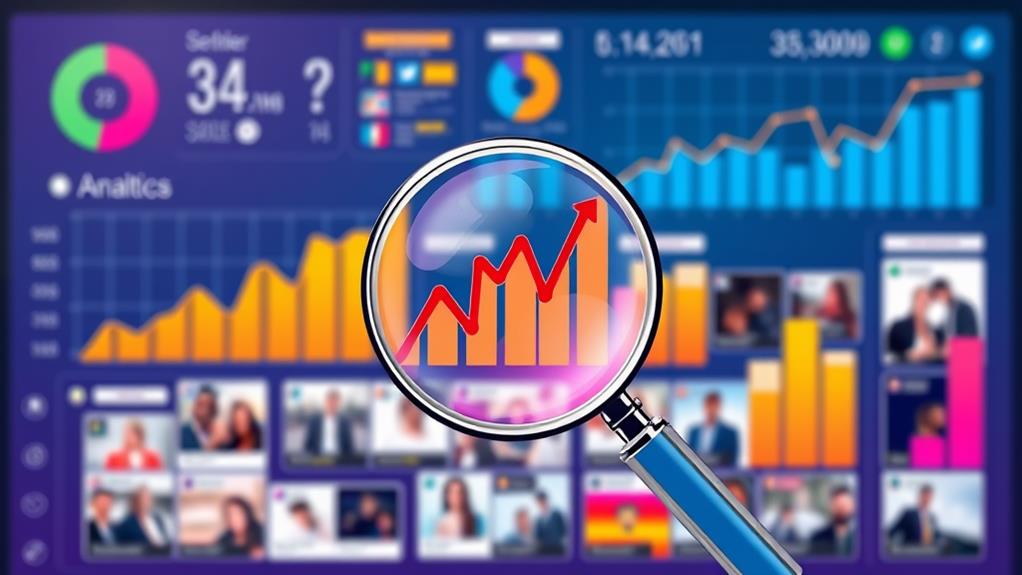Leveraging analytics is essential for refining your social media engagement strategy. By tracking key metrics like likes, shares, and comments, you can optimize content to resonate better with your audience. Regular review of these analytics helps you stay aligned with emerging trends and audience preferences, ensuring continual improvement. Implementing SMART criteria for goal setting allows for clear measurement and alignment with broader business objectives. Tools like Sprout Social and Google Analytics enhance this process by offering detailed insights. Regular testing and iteration based on data-driven decisions can greatly boost engagement rates, leading to higher ROI and more targeted content strategies.
Key Takeaways
- Track engagement metrics like likes, shares, and comments to understand content performance and audience preferences.
- Use demographic segmentation to tailor content based on age, gender, and location for higher engagement.
- Set SMART goals to provide clear benchmarks and measurable objectives for your social media strategy.
- Regularly review analytics to adapt to emerging trends and refine strategies for sustained relevance.
- Prioritize high-impact content creation through A/B testing and posting during peak interaction times.
Importance of Analytics
In today's digital landscape, the importance of analytics in social media engagement cannot be overstated. Social media analytics empower businesses to gather and interpret data from various platforms, offering essential insights into audience engagement. This data interpretation is vital for optimizing marketing strategies, as it allows brands to track key metrics such as likes, shares, and comments.
By examining these engagement patterns, companies can identify the most effective content types, thereby enhancing their strategic approach. Audience segmentation, derived from analytics, enables companies to tailor their content based on specific demographics and online behaviors. Such targeted content considerably boosts engagement rates, making interactions more meaningful and effective.
Leveraging tools like Demographics Reporting helps in refining content strategies based on precise audience data. Furthermore, data-driven decisions informed by social media analytics notably improve return on investment (ROI). By meticulously tracking the journey from engagement to conversion, businesses can refine their strategies to maximize outcomes.
Additionally, regular review of analytics guarantees that brands stay ahead of emerging trends, allowing them to adapt strategies in real-time. This agility is vital for maintaining relevance in a rapidly evolving digital environment.
Setting Goals and Objectives
Establishing clear goals using the SMART criteria is fundamental for any robust social media engagement strategy, as it provides a structured approach to measure and drive performance.
For instance, setting specific targets such as increasing engagement rates by 15% within three months offers precise benchmarks against which success can be tracked.
Additionally, aligning these specific objectives with broader business goals guarantees that your engagement strategy contributes to overall company success.
Regularly reviewing these goals in light of performance metrics guarantees adaptive strategies that remain aligned with audience preferences and business objectives.
Establishing Clear Goals
Clarity in goal-setting is the bedrock of an effective social media engagement strategy, allowing for precise measurement of success and focused efforts. Establishing clear, specific goals guarantees goal alignment with your broader business objectives and refines your approach to engaging your target audience. For instance, a goal to increase brand awareness might involve achieving a specific follower count, such as gaining 1,000 new followers within three months.
Regularly reviewing and adjusting these goals based on performance metrics, such as engagement rates and conversion rates, is vital for maintaining relevance and effectiveness. This iterative process guarantees that your social media objectives evolve in tandem with shifting market dynamics and audience preferences.
Clear objectives also facilitate the selection of relevant key performance indicators (KPIs), such as reach, engagement rate, and click-through rate, which are essential for tracking progress and optimizing strategy.
Effective goal-setting fosters accountability within your team, as clearly defined targets enable members to focus their efforts and evaluate their contributions to the overall social media strategy. By aligning efforts with specific, measurable goals, your team can achieve greater cohesion and drive impactful social media outcomes.
SMART Criteria Implementation
Implementing the SMART criteria in goal-setting transforms abstract aspirations into concrete, actionable objectives. SMART applications guarantee that goals are Specific, Measurable, Achievable, Relevant, and Time-bound, thereby enhancing clarity and focus in social media strategies. For instance, a specific goal example might be increasing brand awareness by achieving a 20% rise in follower count within three months.
- Specific: Clearly defined goals, such as "increase brand awareness," provide a direct target for measurement, eliminating ambiguity.
- Measurable: Establishing measurable objectives, like tracking a 20% rise in follower count, enables the monitoring of progress through key metrics such as engagement rates. This allows for data-driven adjustments to strategies if targets are not met.
- Achievable: Goals need to be grounded in reality, considering the current resources and capabilities of the organization. Setting attainable objectives guarantees that efforts are realistic and feasible within the given timeframe.
Regularly reviewing and adjusting goals based on performance metrics is essential. This fosters continuous improvement and guarantees alignment with overall business objectives.
Identifying Key Metrics
To effectively measure social media engagement, it is essential to align key metrics with specific business goals.
Prioritizing engagement rate can provide actionable insights into content resonance, while monitoring click-through and conversion rates helps evaluate the effectiveness of driving and completing desired actions.
Additionally, analyzing reach and follower growth rate offers a broad view of audience expansion and content visibility, guiding strategic improvements.
Utilizing third-party tools can further enhance insights by providing real-time data and detailed reports, aiding in optimizing content strategies.
Aligning Metrics With Goals
Selecting key metrics that precisely align with specific social media goals is foundational to an effective engagement strategy. Metric relevance and goal alignment are critical to guaranteeing that the data collected directly informs strategic decisions. For instance, tracking engagement rate (likes, shares, comments) is essential for brand awareness campaigns, whereas conversion rate is more suited for lead generation efforts.
To implement a robust strategy, consider the following steps:
- Define Objectives: Clearly articulate what you aim to achieve, whether it's increasing brand awareness, generating leads, or enhancing customer loyalty.
- Select Relevant Metrics: Choose metrics that directly measure progress toward your objectives. For example, use click-through rate to assess content effectiveness in driving traffic.
- Regularly Review and Adjust: Continuously analyze performance data to guarantee the selected metrics remain aligned with evolving business goals.
Avoiding irrelevant metrics, such as total follower counts without context, helps concentrate efforts on meaningful interactions and conversions.
Prioritizing Engagement Rate
Building on the importance of aligning metrics with goals, prioritizing engagement rate emerges as a vital strategy for gauging the effectiveness of content and its resonance with the target audience.
Engagement rate, calculated by dividing total interactions (likes, comments, shares) by total reach or impressions and multiplying by 100, serves as a barometer for content success. High engagement rates indicate that the content aligns well with audience interests, making the analysis of post types essential for refining engagement tactics.
Tracking engagement rates over time provides brands with valuable insights into audience preferences and trends. This continuous monitoring allows for timely adjustments to content strategies, ensuring sustained relevance and impact.
By focusing on engagement rates, brands can segment their audience more effectively, tailoring content to specific groups and enhancing overall engagement.
Prioritizing engagement rates encourages the creation of high-impact content that not only drives interactions but also fosters a sense of community among followers.
This strategic focus on engagement helps in optimizing social media performance, leading to improved brand visibility and loyalty.
Ultimately, a data-driven approach to engagement rate analysis positions brands to better meet their audience's needs and achieve their social media objectives.
Actionable Insights for Improvement
Understanding which metrics to focus on is crucial for deriving actionable insights that drive social media success. Key metrics such as engagement rate, click-through rate, and conversion rate are significant in evaluating the effectiveness of social media content and identifying areas for improvement.
Regular tracking of these metrics sheds light on user behavior and content resonance, allowing for timely adjustments to content strategy based on performance data.
To maximize social media engagement, brands should prioritize actionable metrics over vanity metrics. Here are three important metrics to focus on:
- Engagement Rate: Measures the level of interaction users have with your content, including likes, comments, shares, and saves. This metric helps assess content resonance and user behavior, providing insights into what content resonates most with your audience.
- Click-Through Rate (CTR): Indicates the percentage of users who click on a link within your post or ad. A high CTR signals effective call-to-actions and compelling content that drives traffic to desired destinations.
- Conversion Rate: Tracks the percentage of users who complete a desired action, such as making a purchase or signing up for a newsletter. This metric is essential for evaluating the success of campaigns in meeting specific business objectives.
Utilizing tools like Google Analytics and Sprout Social facilitates thorough tracking, enabling data-driven decision-making to enhance social media engagement strategies.
Audience Insights
Gaining robust audience insights is essential for a data-driven social media engagement strategy. Utilizing demographic segmentation, brands can reveal critical information about their audience, such as age, gender, and location. This data enables the creation of tailored content that resonates more effectively with target segments, facilitating engagement optimization.
Analyzing metrics like engagement rates by reach and follower growth rate can additionally refine content strategies. Moreover, tracking how Instagram Stories and Reels perform can provide valuable insights into audience behaviors and preferences.
Analyzing engagement patterns reveals peak interaction times, allowing brands to strategically schedule posts to maximize visibility and interaction. This precise timing can greatly amplify engagement rates.
In addition, understanding audience interests and online behaviors permits companies to align their content with follower preferences, thereby enhancing overall engagement.
Regular monitoring of audience insights is pivotal. It allows brands to adapt their strategies proactively in response to evolving demographics and preferences, guaranteeing content remains relevant and engaging.
Additionally, insights into audience sentiment towards specific content types can guide brands in prioritizing high-performing formats, such as videos or polls. This targeted approach guarantees that resources are allocated efficiently, yielding higher engagement.
Content Strategy Optimization

Effective content strategy optimization is essential for maximizing social media engagement. By leveraging analytics, businesses can enhance content performance and better cater to their audience through strategic adjustments. Here are three key factors to bear in mind:
1. Content Performance Analysis: Tracking engagement metrics such as likes, shares, and comments is vital. Data shows that video content can generate up to 1200% more shares than text posts.
Regular content audits allow businesses to identify high-performing posts and focus on similar content to drive engagement. Additionally, using tools like Sprout Social can provide in-depth reporting and competitor analysis to further refine content strategies.
2. Optimal Posting Times: Analyzing audience engagement patterns reveals the best times to post, greatly boosting visibility and interactions. Sharing content during peak times can increase engagement by up to 50%, ensuring that posts reach a larger, more active segment of the audience.
3. A/B Testing: Implementing A/B testing for different content formats and messages can enhance engagement rates by 33%. This approach identifies what resonates best with distinct audience segments, allowing for more targeted and effective content distribution.
Continuous optimization, supported by detailed analytics, can lead to a substantial 70% improvement in overall social media performance. By focusing on content performance and audience segmentation, brands can refine their strategies to achieve higher engagement rates.
Measuring ROI
Optimizing content strategy is only part of the equation for achieving robust social media engagement; equally important is the ability to measure the return on investment (ROI) effectively.
Measuring ROI in social media involves tracking the journey from engagement metrics, such as likes and shares, to conversion metrics like sales or lead generation, providing insight into the effectiveness of campaigns. By implementing conversion tracking and analyzing engagement funnels, businesses can determine which platforms yield the highest conversion rates, thereby allocating resources more strategically.
Tools like TubeBuddy and VidIQ can aid in enhancing engagement strategies and offer demographic insights that are essential for refining content.
A study revealed that brands using social media analytics to measure ROI reported a 30% increase in overall marketing effectiveness and a 25% improvement in customer engagement. This underscores the significance of regular ROI evaluation, which not only justifies social media investments but also informs future campaign adjustments.
Identifying successful campaigns through ROI measurement enables brands to replicate effective tactics, fostering continuous improvement in their social media strategies.
Ultimately, a data-driven approach to measuring ROI allows businesses to align their social media efforts with broader business objectives and audience needs, ensuring a more impactful and efficient marketing strategy.
Using Analytics Tools

Harnessing the power of analytics tools is essential for crafting a successful social media engagement strategy. Platforms like Sprout Social and Hootsuite offer extensive reporting capabilities, enabling marketers to track key engagement metrics, such as likes, shares, and comments. These insights facilitate the evaluation of content performance and the refinement of marketing approaches.
Additionally, using Pinterest Analytics can provide actionable insights into audience behavior and preferences, which can be vital for optimizing your social media strategy.
Incorporating data visualization techniques within these tools allows for a clearer interpretation of complex data sets. Google Analytics further enhances this by integrating social media metrics with website traffic insights, providing a holistic view of how social media efforts contribute to conversions and user actions.
For a robust strategy, consider the following:
- Tool Comparison: Evaluate tools like Sprout Social, Hootsuite, and BuzzSumo to determine which best meets your specific needs. Each platform offers unique features, from extensive reporting to sentiment analysis.
- Data Visualization: Utilize visual aids to simplify the interpretation of data, making it easier to identify trends and patterns.
- Sentiment Analysis: Advanced tools offer sentiment analysis to gauge audience emotions towards your brand, enabling more refined and responsive engagement tactics.
Testing and Iteration
To fine-tune your social media engagement strategy, embracing a cycle of testing and iteration is vital. Continuous testing of various content types, posting times, and messaging styles allows for the identification of the most effective strategies tailored to audience preferences and engagement patterns.
Leveraging TikTok analytics can provide valuable insights into audience behavior, which is essential for optimizing content. By implementing A/B testing, marketers can compare visual variations and different captions to determine which elements yield higher engagement rates. This iterative approach is fundamental for content refinement and guaranteeing alignment with audience interests.
A robust testing framework involves regularly analyzing results from different campaigns to pinpoint successful elements. Documenting and reviewing these outcomes builds a thorough understanding of what resonates with the target audience. Such data-driven insights are invaluable for optimizing future marketing efforts.
Feedback integration is another important component of this process. By incorporating audience feedback into the testing process, marketers can develop a responsive strategy that adapts to changing preferences and interests. This not only enhances engagement rates but also fosters a stronger connection with the audience.
Ultimately, adopting iterative strategies and a detailed testing framework guarantees that social media engagement efforts are continually refined and optimized, driving sustained success and growth.
Staying Ahead of Trends

Embracing a cycle of testing and iteration naturally sets the stage for staying ahead of trends. Social media analytics enable brands to identify emerging trends in real-time, therefore allowing for timely adjustments to content and strategies that align with audience interests.
Through trend forecasting and audience prediction, brands can adapt their content to meet the changing preferences of their followers, guaranteeing sustained engagement. Additionally, by building authentic relationships with brands and staying transparent about performance metrics, influencers can create a stronger rapport that benefits both parties.
Regular review of analytics is essential for staying informed about shifts in social media algorithms and user behavior. This proactive approach guarantees that strategies remain relevant and effective. Utilizing trend analysis from social media data can lead to a 35% increase in audience engagement by aligning content with current topics of interest.
To strategically stay ahead of trends, brands should:
- Monitor Industry Dynamics: Continuously track changes in the social media landscape to swiftly adapt to new trends.
- Leverage Real-Time Data: Use real-time analytics to fine-tune content and strategies, addressing audience needs promptly.
- Review and Adapt: Regularly evaluate analytics to stay updated on algorithm changes and user behavior shifts, guaranteeing content remains compelling.
Brands that proactively adapt their strategies based on trend insights experience a 50% higher success rate in campaign effectiveness compared to those that do not leverage analytics.
This data-driven approach not only enhances engagement but also fortifies the overall social media strategy.
Frequently Asked Questions
How Do You Use Analytics to Increase Engagement on Social Media?
To increase engagement on social media, utilize analytics to assess content performance and gain audience insights. Tailor content to audience demographics and preferences, optimize posting times, and prioritize high-performing content types based on engagement metrics.
How Does Analytics Help Social Media?
Analytics provides valuable audience insights and demographic analysis, enabling brands to optimize content performance. By monitoring engagement metrics, companies can refine strategies, increase interactions, and guarantee their social media efforts align with audience preferences and behaviors.
What Is the Best Strategy to Increase Social Media Engagement?
The best strategy to increase social media engagement involves enhancing content quality and precise audience targeting. Analyze audience insights to tailor content, optimize posting times, focus on high-performing formats, and employ interactive strategies, continuously iterating based on performance metrics.
How Can Analytics Help the Business With Their Social Media Strategy?
Analytics assist businesses by providing audience insights and performance metrics, enabling content optimization and trend analysis. Through competitor benchmarking and campaign evaluation, businesses can strategically refine their social media strategies to enhance engagement and maximize ROI.
Conclusion
The strategic application of analytics greatly enhances social media engagement by enabling data-driven decisions. By setting clear goals, identifying key metrics, understanding audience insights, optimizing content strategies, and measuring ROI, organizations can refine their approach for maximum impact. Utilizing advanced analytics tools, continuously testing, and iterating based on findings further guarantees alignment with evolving trends. Ultimately, an analytics-focused methodology fosters more effective and efficient social media engagement, driving sustained growth and competitive advantage.




